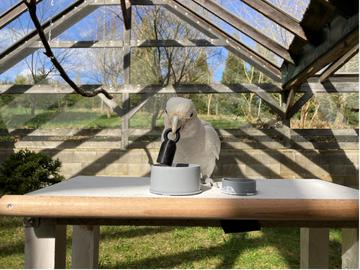Researchers have found that Goffin’s cockatoos choose lighter objects over visually identical heavier ones, offering new insights into their decision-making strategies. The study, a collaboration with University of Veterinary Medicine Vienna, reveals that these birds favour lighter objects in a way that reflects a refined energy-saving strategy.

One of the Goffin's cockatoos, Figaro, placing a weight on the landing platform during a flight test
Image: Antonio J. Osuna-Mascaró
The study builds on previous findings that Goffin’s cockatoos outperform primates such as chimpanzees and capuchin monkeys in weight discrimination tasks. Researchers suspected that the cockatoos’ ability to fly might contribute to their sensitivity to weight, as transporting a heavy object in flight demands considerable energy management.
The cockatoos were presented with two visually identical kettlebell- and dumbbell-shaped objects that differed only in weight. Each trial required the birds to transport one of the objects over a short distance, either by walking or flying, to receive a reward. Each object yielded the same reward, ensuring that their preferences reflected weight considerations alone. Even with a subtle 30% weight difference, most cockatoos quickly developed a preference for the lighter option.
The birds then encountered a choice between two dumbbell-shaped objects with equal overall weight but differing balance, where one object had an uneven weight distribution. Despite expectations, the cockatoos showed no significant preference between balanced and unbalanced options, suggesting that for their transport tasks, weight rather than balance is the primary factor in their decisions. Célestine Adelmant, co-lead author who completed this research as part of a Masters in the Department of Biology, said:
“Whereas the weight of objects might be used to determine the nutritional content of nuts and seeds in natural populations, object imbalance has little nutritional relevance, so birds may not have evolved mechanisms to detect or counteract this cue.”
During these trials, the cockatoos often exhibited ‘switching’ behaviour, picking up one object before setting it down and returning to the other, back and forth, before making a final choice. Dr Antonio Osuna-Mascaró, co-first author from the Messerli Research Institute, interprets this as a sign of their decision-making process:
“When cockatoos switch between objects, it may indicate uncertainty — a behaviour we’ve noted in past studies. This switching could reflect metacognitive awareness, suggesting that the birds are exploring their own knowledge to evaluate both options.”
Contrary to expectations, the cockatoos did not display an increased preference for lighter objects when flying (a higher-energy activity) compared to walking. The researchers suggest this may be due to a trade-off between the physical effort of carrying heavier objects and the cognitive load of making an informed decision.
Professor Alice Auersperg, head of the Goffin Lab in Vienna, reflected on the findings:
“The cockatoos’ preference for lighter objects fits well with optimal foraging theory, suggesting a strategy for energy efficiency that could be critical in their natural foraging behaviours. Building on this, future experiments could explore how these birds handle tool transport when faced with objects of different weight distributions or when weight impacts tool functionality. Such studies could reveal even more about how birds navigate the balance between physical effort and cognitive demands in complex tasks.”
To read more about this research, published in Scientific Reports, visit: https://www.nature.com/articles/s41598-024-76104-7